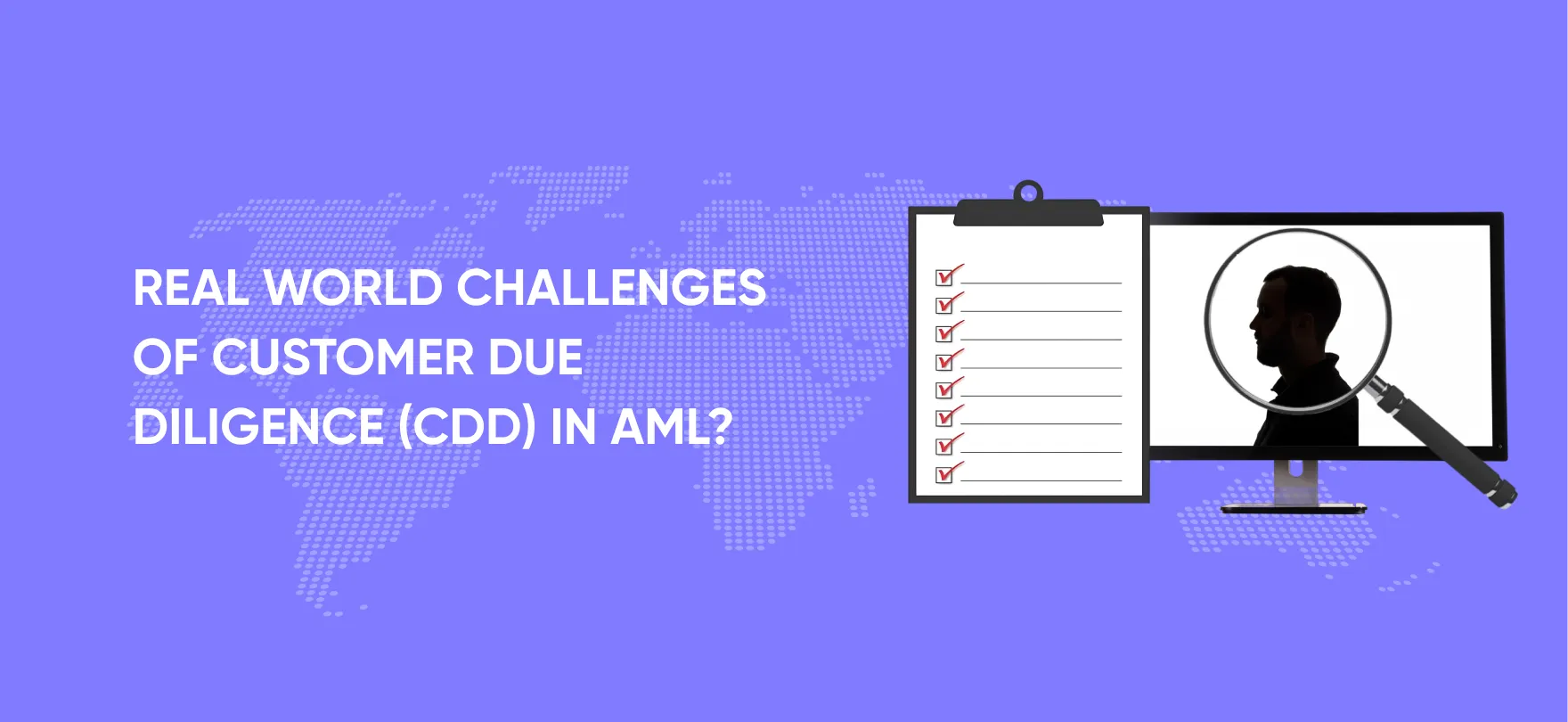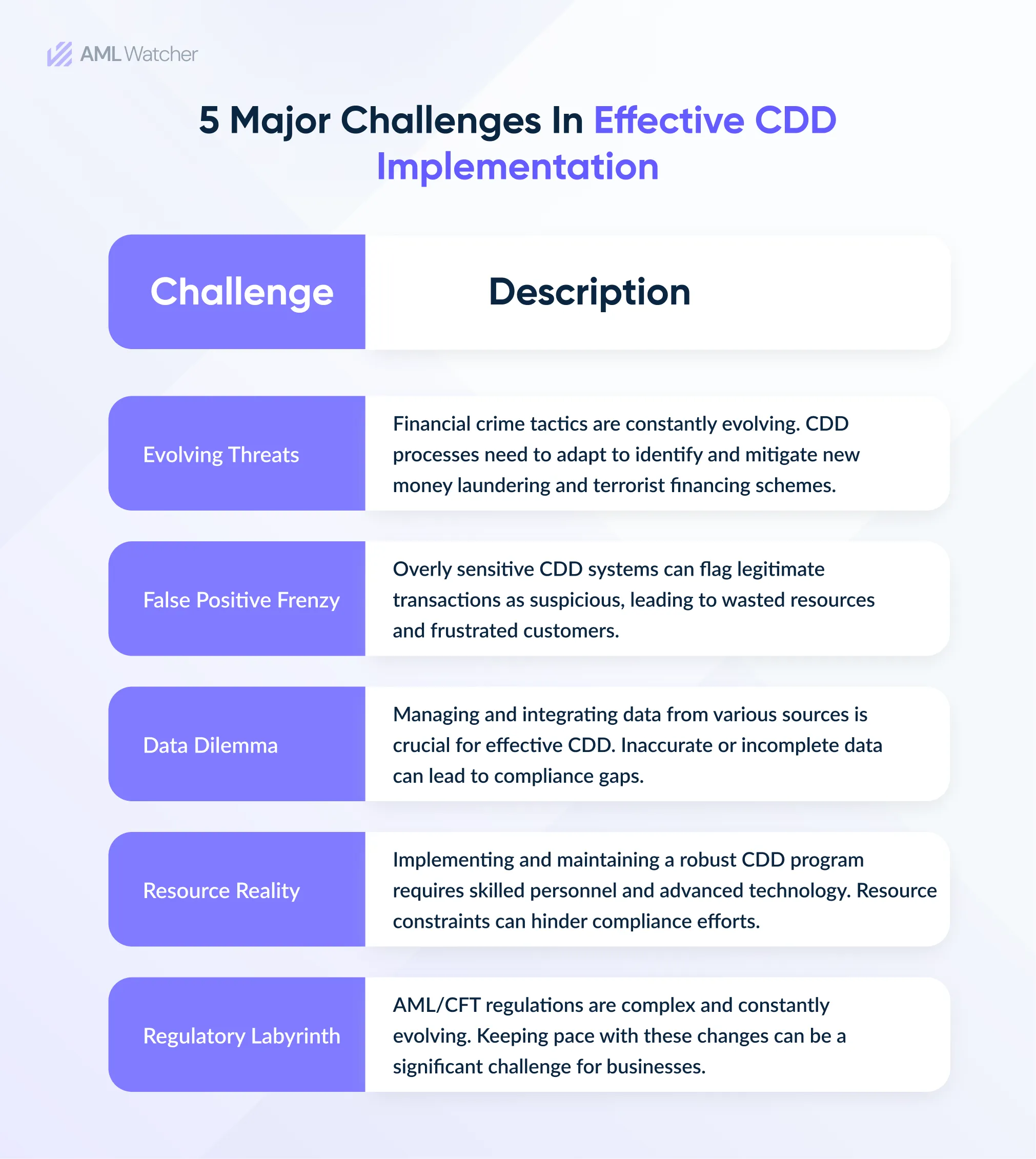
Real World Challenges of Customer Due Diligence (CDD) in AML?
Failure to anti-money laundering (AML) controls caused more than $6.5 billion to businesses in 2023. But why? Do you think it’s because of a lack of customer due diligence CDD in AML or is it just inefficient and sluggish CDD measures taking a toll on AML compliance?
Cdd due diligence is a must whether businesses deny it or accept it because if compliance cost is scary then one hasn’t come across the cost of non-compliance. It would be unfair to call out businesses with minimum to no compliance for money laundering (ML) and financing of terrorism, thanks to the unending regulatory web and complex AML solutions available in the market.
We mentioned the scale of AML penalties for not abiding by the AML/CFT laws even though the market of AML solutions is predicted to exceed $6.8 billion by 2028. The challenges persist because adherence to compliance requires more than simple due diligence. What does it take to efficiently cater to real-time compliance challenges?
In this article, together, we will explore the intuitive need for CDD AML compliance, hard-core business challenges in implementing CDD measures, and how one can articulate these challenges.
What is Customer Due Diligence meaning in AML?
If we refer to AML compliance as a building protecting the financial system, customer due diligence (CDD) acts as a foundation of the building.
In simple words, CDD meaning in AML is the process of collecting and verifying customers’ or business partners’ information including business nature, source of wealth, and transactional patterns. The CDD involves the assessment of potential AML risks involving new and existing clients.
With one unified motive to clean and protect financial systems from corrupt actors, the concept of AML customer due diligence coupled with appropriate risk assessment is the key.
With an inheritance of an immune system, deploying efficient customer due diligence checks on the background of clients and business partners for detecting potential compliance risks, customer due diligence AML allows businesses to check the following five boxes.
5 Key-Checks of Efficient CDD in AML Compliance
Client Identification and Verification
Customer due diligence allows businesses to collect basic information about customers including name, date of birth, and certificate of residence (valid ID information) that also meets the purpose of KYC (Know Your Customer).
Identifying and verifying customer data enables businesses to stop corrupt actors from infiltrating the system from illicit activities.
Check on Source of Wealth & Funds
Illicit financial activities such as money laundering and associated crimes are motivated by the influx of dirty money. CDD in AML requires businesses to keep a check on the source of wealth and funds of customers and partners to analyze the level of risks they carry to commit any financial fraud.
It is crucial to understand the nature of a client’s business and source of income so a large deposit or transaction would raise a suspicion of potential money laundering.
Identification of Beneficial Ownership
Adherence to strict AML regulatory guidelines requires businesses of all sizes to identify the beneficial ownership of any account or business. Increasing financial crimes behind the disguise of shell companies demand businesses to know the real owner and controller of opened accounts.
If you are a business dealing with high-risk entities and politically exposed persons (PEPs), acquiring beneficial ownership identification can save you from unforgiving non-compliance consequences.
The dynamic regulatory environment is not flexible to PEP non-compliance. Learn about PEP Screening and why is it inevitable to uplift your AML compliance game.
Risk Assessment & Ongoing Monitoring
Developing a customer risk profile is not everything that AML customer due diligence checklist requires, there is more to it. Continuously monitoring a customer’s transactional activity and keeping an eye on changing profiles is essential for compliance checks.
Efficient CDD is not completed without regularly evaluating AML risks to spot potential illicit activities by tracking transactions and updating the risk profiles of high-risk clients.
Recordkeeping and Reporting
AML customer due diligence requirements do not stop at managing the risk levels or knowing your customers, they extend to maintaining detailed records of information collected for CDD purposes.
Regulatory bodies expect businesses to have trails of compliance documentation including risk assessments, AML/KYC documents, and SARs (Suspicious Activity Reports) filed against potential illicit activity.
Having the key CDD Requirements in AML explained, the secret and subtle ingredient of meeting regulatory compliance demands is the inclusion of the Risk-Based approach in the AML framework.
The global regulatory watchdog, FATF (Financial Action Task Force) recommends institutions adopt a risk-based approach in their CDD AML framework. It allows businesses to optimally allocate compliance resources and have efficient AML case management.
Fulfilling the AML customer due diligence checklist is endorsed by the team’s good guys. However, the need of the hour is to highlight real-time challenges businesses face while implementing CDD controls to fight against money laundering and financing terrorism.
Let’s get to the challenges that require immediate attention.
The Dirty Little Secrets of CDD Implementation
The increasing AML penalties prove that despite growing strictness in regulatory expectations, real-world challenges in the practical deployment of CDD measures are left unresolved. Time constraints made me discuss a few of them.
Increased Sophistication of Financial Crimes
Compliance has not been just limited to catching criminals with leather bags full of cash as shown in movies. It is way more complicated than this, thanks to technological advancements. Not that technology asked to be used in the meanest way possible but if we do not use it against corrupt actors, they will use it.
E-wallets and crypto are not infamous for no reason as Binance (Cryptocurrency exchange company) was imposed with a $4.38 million fine by the FINTRAC for violating anti-money laundering and countering the financing of terrorism (CFT) laws.
The use of advanced and vague tactics makes it difficult for businesses with limited AML compliance solutions to keep a check on such entities resulting in fraudsters exploiting the system.
Substandard CDD measures and failed AML in Banks lead to consequences businesses are not ready to embrace. Learn how four big banks turned their compliance game around the corner.
Alarming False Positives & Resource Bleeding
There might be multiple reasons why businesses spend leg and arm to deal with massive false alarms dubbed as AML false positives, including inadequate and inconsistent data integration coupled with complex technological adaptation, and the list goes on.
What lies at the heart of getting false positives is the driving factors of risk profiles. The parameters to flag an alarm decide the efficiency of any AML compliance solution whether costly or laced with advanced algorithms.
For instance, a business might get flagged because its past owner was involved in corrupt financial activities while the new owner has nothing to do with all the set factors that keep a compliance officer waste his time on unnecessary investigations.
Below are some more concerning factors that lead to delayed or precisely failed CDD in AML compliance.
Short story long, the practical efficiency of the CDD framework depends on the automation of the AML risk assessment tool allowing a compliance officer to investigate what matters the most unlike digging deeper into false AML alarms.
Automation of the CDD/AML tools is just the tip of the iceberg. Let’s see what else can help your business achieve functional compliance results you have been losing your sleep over.
3 Ways to Achieve Realistic CDD Goals
Since it is always easier said than done, are we ready to talk about the solutions that not only enable businesses to keep pace with ever-evolving AML regulations but are also easy to employ within limited compliance resources? Let’s dig into them.
Is Your CDD/AML Tool Automated?
The enforcement of unforgiving AML laws is scaring businesses instead of making them work smartly, it is sad but true. Automating the CDD/AML tool with your business development and onboarding tools means smartly assessing and managing AML risks.
A client or a business partner initiates the deal along with their basic but important background information, the automated AML tool picks the information and scans it against globally recognized AML data including sanctions lists, PEPs networks, corruption lists, and regional barred lists, fancy isn’t it?
The perks of automation are not limited to faster risk assessments but also allow businesses to thoroughly screen and investigate higher-risk clients. It also provides well-maintained CDD/AML records in the form of authentically curated documentation for regulatory audits.
Can You Uncover Fraudsters with Adverse Media Screening?
The probability of a new client or business partner highlighted in negative news is equally valid as being on a corruption or barred list that dictates their potential to exploit financial systems. The fight against corrupt actors can be armed by spotting them in adverse media checks.
Detecting potential fraudsters through negative news screening allows businesses to know who they are dealing with. A reputationally damaged individual is prone to committing financial fraud even though he is not an alleged criminal, allowing efficient and risk-based customer due diligence process in AML compliance measures.
402.74 million terabytes of data are produced daily. In the age of overloaded information, learn how to manage AML risks with Adverse Media Screening.
Are You Aware Of Your Customer’s Story?
Achieving efficient CDD goals can not be fully relied on technology because no intelligence can trespass the human intellect and judgments. Having tech-embedded AML tools is ideal but knowing your customer’s story is the cherry on the cake.
Understanding your customer’s history along with optimal risk scoring enables you to secure new businesses and thrive with accountability. Akin to long-term investment, paying attention to the unique story of your business partner not only enriches AML efforts but also builds a strong business relationship and trust.
How Does AML Watcher Ease Your Compliance Struggles?
Highlighting the problems is everybody’s task but coming up with practical and functional solutions is what it takes to be a pioneer. AML Watcher with its primary aim to make compliance simply accurate, presents real-time solutions for harmonized CDD in AML compliance.
Whether it’s about staying ahead of regulatory updates or simply customizing risk scoring, AML Watcher has your back in handling a flood of false alarms generated due to inappropriate risk parameters.
Overcome your compliance indecisiveness and choose wisely because corrupt actors do not sit idle when they decide to pollute your compliance framework. Get in touch with compliance geeks at AML Watcher and be aware of the unknown.
We are here to consult you
Switch to AML Watcher today and reduce your current AML cost by 50% - no questions asked.
- Find right product and pricing for your business
- Get your current solution provider audit & minimise your changeover risk
- Gain expert insights with quick response time to your queries




